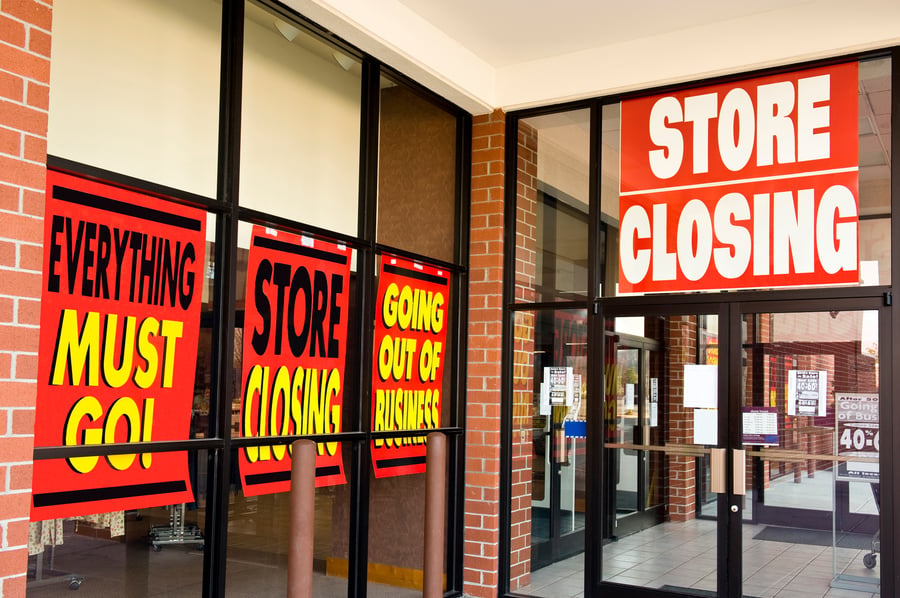Lina Chindamo is a Certified Credit Professional with over 25 years of experience in credit risk management. She has held senior leadership positions at companies like Sony Electronics, Maple Leaf Foods, and Mondelez Canada. Her extensive experience and current role, where she collaborates with c-suite partners and credit teams across various industries, make her a respected figure in the credit industry.
2023 has been rough for American businesses overall. But it’s been particularly bad for retailers.
According to our data, retail bankruptcies increased by 64.75% in the first half of 2023 (January to June 2023), compared to the same period last year. To put this into context, the agriculture industry fared much better, with bankruptcies dropping by 26.32%. Meanwhile, the wholesale industry has faced its own financial struggles, with bankruptcies rising 54.05% in the first half of 2023, compared to last year.
But what’s really startling about these figures is that a lot of retailers have been flush with cash. Yet they’ve still worked up a massive amount of debt.
Here are some examples of this happening recently:
- Shoe company Rockport Group generated over $203 million in revenue in 2022. But in 2023, the organization filed for bankruptcy due to being $47 million in debt with its top five creditors.
- It was a turbulent year for Party City. The company looked like it was going to bounce back for a short time, only to fold with an excruciating $1.7 billion in debt.
- Beauty company Forma Brands was on the brink of bankruptcy with an $848 million debt obligation. But it was saved through a buyout from its investor group.
So, why does this happen? There are several reasons that we’ll explore in this blog, both bad and good. Because taking on debt isn’t necessarily a bad thing if there’s a purpose to it.
Bill James, Enterprise Director for Creditsafe, says: “There’s always good and bad debt. Savvy credit managers can tell the difference. Good debt is debt leveraged to grow the business and invest back into it. One way to do this is through accounts receivable. As long as the company has strong annual turnover and good debt collection strategy, that’s good debt.
Bad debt, however, would be if you see a business has maxed out multiple lines of credit. Put another way, it’s the variable types of credit that could potentially be abused by a company that is in a cash current situation.”
How much do you know about your company's debt and risk?
Advantages of taking on more debt
Tax deductions and lower interest rates
Retailers can take on debt to be entitled to tax reductions and lower interest rates. So, when you’re making interest payments, your borrowing funds may be tax-deductible. In this situation, you’re writing off bad debt. This could be loans you make to a supplier or credit sales.
To be able to write off the debt and be eligible for the tax deduction, you must have made a reasonable attempt to recover what’s been owed. Think about context too. Following up with a letter to collect a sum of a few thousand dollars would be considered reasonable. For a debt that covers tens of thousands – or even millions of dollars – legal action would need to be taken.
You can also deduct interest paid on certain kinds of business loans (i.e. purchasing equipment or borrowing money to buy another business). The advantage here is that you can use any capital that comes from this debt to be able to continue to finance business operations.
Equity control
Debt financing is an option for retailers who want to maintain control of a company, while also not having to rely on physical assets to offset repayments. This can be a better option than equity financing for a couple of reasons.
Firstly, if you give someone equity in the business, that means they will have a say in the direction of the company and it may not be the direction you want to go in. Secondly, you might have decided to give equity to some of your employees in the early stages of the company and you now want to buy them out.
Reinvesting for growth
There are also times when having excess cash is beneficial for company growth. The first advantage is providing more flexibility for retailers in a competitive environment, particularly with all the uncertainty plaguing the 2020s. For example, a sudden labor shortage can cripple a company and shut down operations in key locations. But a retailer with excess cash can still afford to pay workers and not lay anyone off.
Another advantage is using leftover cash to invest in key growth areas. This could be in marketing to ramp up holiday sales or carry out detailed supply chain audits to make sure you aren’t going to be hit with cash flow losses in the near future.

Disadvantages of taking on more debt
Indication of financial distress
Of course, there are times when having excess cash and being millions of dollars in debt are a bad combination. And one of the greatest disadvantages is when it becomes clear to investors, lenders and customers that you’re on a path towards bankruptcy.
Lenders will certainly run a credit check on your business and look at a combination of data points to see how strong your financials are, how you’re keeping up to date with payments, if your credit score has dropped drastically and suddenly in recent months, among other data points. Don’t assume that just because one particular data point might look better than others, it’ll make lenders feel confident in your finances. They will look at everything and make an informed decision based on a holistic approach.

Red flags that they’ll look out for include:
- DBT scores of 15+ days: A DBT score refers to the number of days past the payment terms that a company pays its bills. So, if a company has a DBT of 25 and they have agreed to 60 day payment terms, those invoices are paid within 85 days of the invoice date. This score will be taken into consideration alongside other points like company size and payment terms. Generally, 5 - 10 days is an acceptable DBT, but investors will also make a DBT peer analysis and rank you against other businesses in your sector.
- Sudden and prolonged changes in DBT scores: If your DBT score has suddenly dropped (by a significant amount) in recent months, that can be a sign of trouble ahead. Let’s look an example for context. Let’s say your DBT was 7 for an entire year and then it spiked up to 25 and has stayed there for the last six months. That’s a clear sign that something is wrong. It could be that the company has experienced a significant drop in sales, while its operating expenses have gone up. This could all be putting a strain on cash flow and making it harder to pay bills on time.
- High percentage of late payments that exceeds 50%: There’s a big difference between a retailer that’s only occasionally late with payments (3 -6%) and a retailer that is consistently late (50%+). Lenders will want to know the reasons why payments are being made late and will look at company size, credit scores, total value of past due payments and other data. Just because a company is paying late, doesn’t mean it’s in dire straits. It could be a short-term issue. And if it has a small percentage of late payments but their value is relatively small (around $10,000), then that’s not too worrying.
- Millions in dollars of debt accruement: For example, $2 million worth of debt could indicate to an investor that you’re overspending and don’t have enough capital to pay off debt on time. Lenders will look at the history of how your debt fluctuates. And continued discrepancies will make them suspicious.
- High credit risk for 12+ months: Credit scores and credit risk go hand in hand. If that risk has been high for a year or more, it could indicate a broader range of issues like being in legal trouble, a decline in annual sales, a decline in net profits, an increase in liabilities and more.
- Sudden drops in credit scores and limits: Following on from the previous points, investors will dig deeper into these two metrics. As Bill James, Enterprise Director for Creditsafe, explains: “It’s important that they get the full picture into a customer’s financial strengths and weaknesses. The sum of all parts is greater than these two data points alone. They should then use the full data picture to make informed decisions about how much credit to extend. Now if you’re considering extending more credit than the recommended limit, you’ll want to look at their trade payment history. How are they paying their bills? Are they paying on time or is it typical for them to pay over 15 days past the payment terms? Do they owe a large amount of money? Has their DBT score dropped significantly in recent months? Look at all these metrics together and follow that trail.”
Pressure from activist investors
Another risk of having a huge amount of cash on your balance sheet and high debt is the presence of activist investors. You could be perceived as not putting cash to work and not investing in profitable situations that can help you offset the debt.
From the investor’s point of view, that’s unacceptable. So, they may start pressuring you to spend the money or increase shareholder dividends. The next thing you know, you’re suddenly in a battle with that investor for control of the company and you’re on the downward slope towards more debt and bankruptcy.

Overconfident management
An overlooked part of excessive cash is how it can change team dynamics. When a business is flush with money, it’s easy for managers to fall into ego traps. We can’t do anything wrong. We’ve got all this money to make our problems disappear. These thoughts may lead to complacency and have a negative impact on the future success of the organization.
Rather than using that money to fix problems, managers start using it to cover up their mistakes and protect themselves against a detailed investigation. Expenses are hidden. Unethical behaviors start to fester. Management becomes reactive instead of proactive. So then, what happens? The company’s market value is destroyed, cash flow takes a hit through overpaying for acquisitions and staff morale is dismantled.

About the Author
Lina Chindamo, Director, Enterprise Accounts, Creditsafe Canada